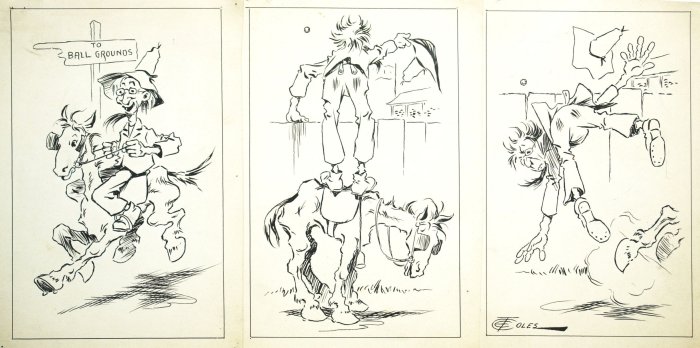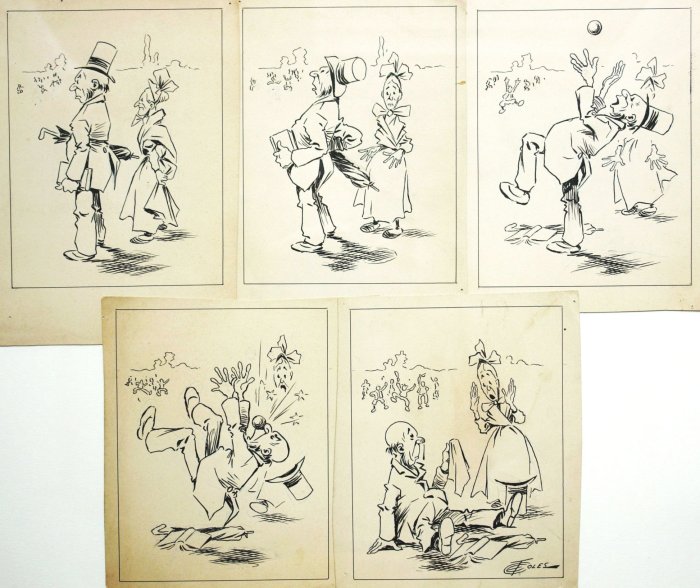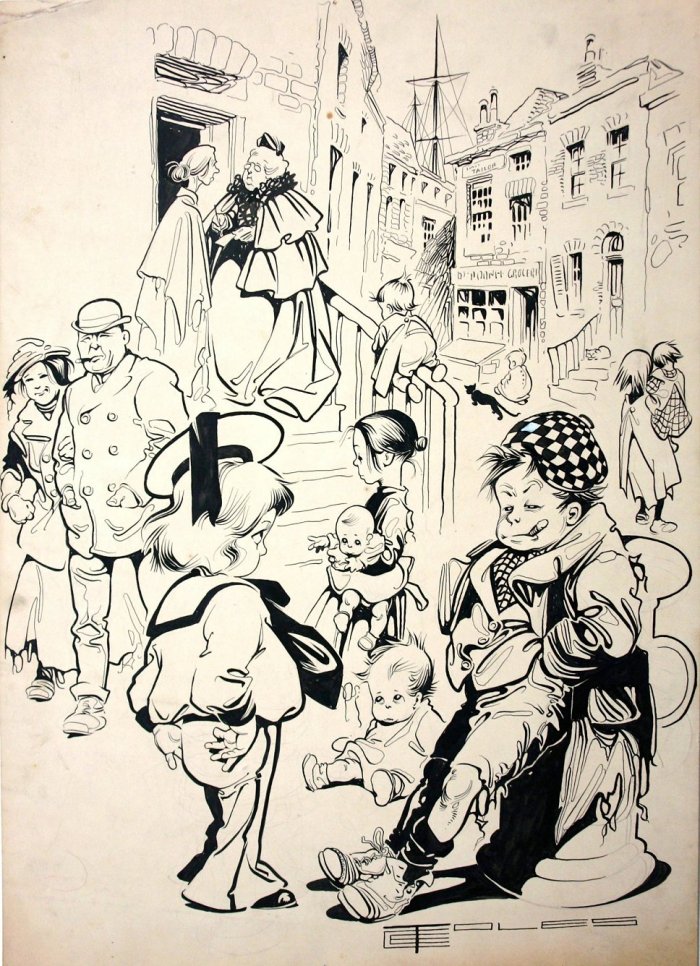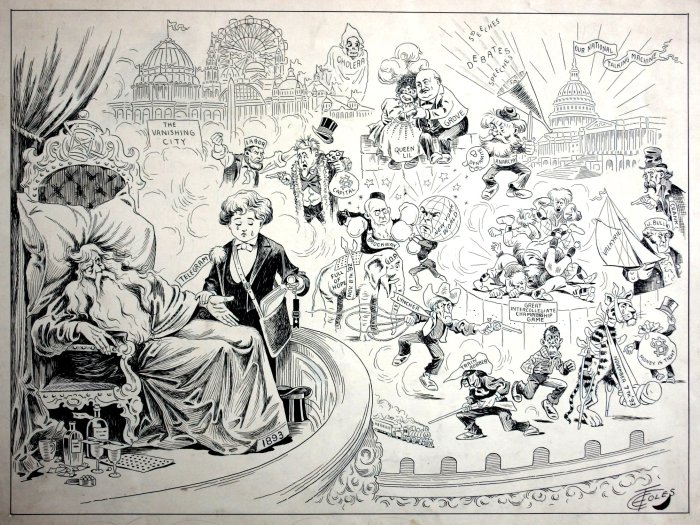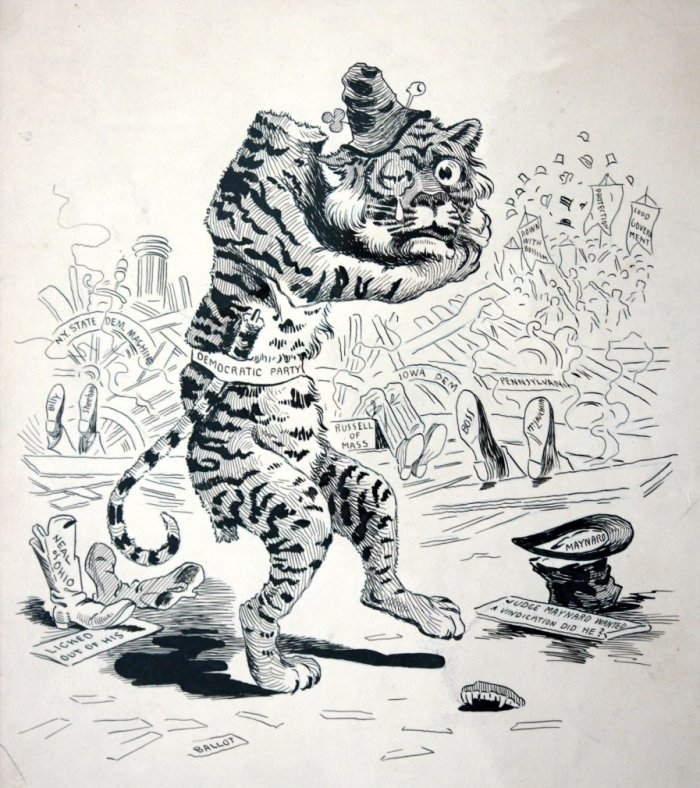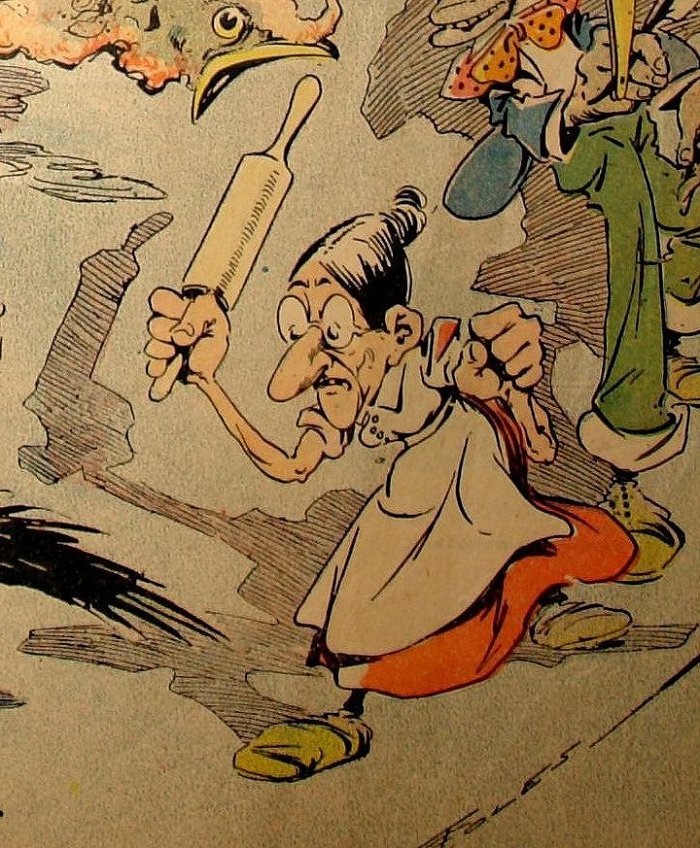A Remarkable Collection: C. E. Toles (1875-1901)
Sometimes we bloggers get lucky. We do up a few posts on some author or artist so forgotten that absolutely nothing is known of their lives and little of their careers, then wake up one day to a correspondence in the mailbox with answers to every question you have ever had about a life lived over 110 years ago. You might describe it as one of those H. T. Webster “Thrill of a Lifetime” moments. Such was the case with the news of the survival of the collection of a newspaper illustrator and cartoonist who flourished between 1894 and 1901 before disappearing from history; the extremely talented and prolific C. E. Toles. Greg Rife was my correspondent and his original post was an eye-opener:
I am writing to you because I recently found some blog correspondence which you exchanged about an artist named “C. E. Toles”. His first name was Claude and he was from Elmira, New York. I happen to be in possession of a wealth of information about Toles. More than twenty years ago, I acquired a number of items from his daughter Virginia. Among the items is a large scrapbook which Claude Toles compiled. Following his untimely death at age 25 Toles’ mother added some memorial information to complete the scrapbook. Most of the album’s contents are newspaper clippings and correspondence which is meticulously mounted in a scrapbook that is about 4 inches thick. Virtually everything about his background, education, death, associates and many accomplishments are in these long forgotten documents. Although unknown today, back then they marveled over how much he accomplished and how famous he was for his tender age.”
The collection contains all of the artwork that was in Toles studio at the time of his death, approximately 108 drawings by Toles himself. Some large completed pieces have the publisher’s receipts attached. Among the original work there are political cartoons, humorous cartoons and some illustrative work. The collection contains four paintings, one in oils the others watercolors. There are also 27 original drawings by his artist friends, among them Gus Dirks, Bernhard Gillam, Will Grefe, Frank H. Ladendorf, and Harrison Fisher. There are five photographs of Toles and his family, and numerous portraits of Toles and other cartoonists among the scrapbook clippings.
The collection contains a 4 inch thick scrapbook of clippings about Toles. The scrapbook is particularly instructive in shedding new light on the early comic art syndicates, (one unknown even to Syndicate historian Elmo Scott Watson) in that short early period (c. 1894-1906) when the caption comics were competing with the emerging, brightly colored, Sunday supplements of Pulitzer and Hearst. Toles saved original letters and telegrams from all of his customers in his scrapbook; Judge, the Journal, the Herald, the Comic Sketch Club, the International Syndicate and many others. The scrapbook features numerous chatty letters from Eugene “Zim” Zimmerman, some illustrated with quick sketches.
There are two 64 page art catalogs published by the International Syndicate in the collection featuring over a hundred cartoons by C. E. Toles, W. M. Goodes, and other cartoonists. One copy is near mint while the other is a worn copy. Most of the artwork is by Toles, some of it under pseudonymous names. The catalogs and publisher’s receipts alone would supply plenty of material for a fat hard-cover book collection.
Also included are 110 illustrated publisher’s receipts featuring single and multi-panel cartoons from his syndicate work and “a wooden jewelry box, which he made for his mother that is a piece of art in itself; meticulously inlaid with different colored woods, forming geometric patterns.”
Claude Eldridge Toles was born in Elmira, New York in 1875 to Wallace and Estelle M. Toles, probably at 503 Baldwin Street, where his mother still resided after her son’s death. For several years Claude Toles was employed by Harris’s dry goods store as a “cash and bundle boy,” lettering window signs, washing windows, and stoking the furnace. According to a January 1901 article in the American Illustrator “In stolen moments, with a spacious packing case for sanctum and studio, he edited, illustrated, and printed with a lead pencil on Manila paper a periodical called “The Check Boy’s Advocate.” A copy of this unique paper secured him a place on the staff of the ElmiraTelegram.” This was in September 1894 and the Telegram offer was made by H. S. Brooks. The position was in the engraving plant at the Elmira Telegram,where he learned and practiced the craft of cartooning.
The job was probably due to the recommendation of his friend and mentor Eugene “Zim” Zimmerman, famous Judge cartoonist, who was living in Elmira at the time and employed by the Telegram. Many of Toles earliest cartoons and illustrations showed a distinct “Zim” influence on art and inking style. Toles contributed numerous political cartoons to the Telegram but at this point in his career he did not become as well-known as his contemporaries.
For some time after leaving the Telegram staff Toles worked independently, as a freelance, in his own office, contributing cartoons to the Telegram, Philadelphia Press, New York Herald and Hearst’s New York Journal color supplements. In 1894 he was selling cartoons to the Texas Sandwich, a comic periodical.
The first person to syndicate newspaper material in US was Moses Y. Beach, owner and publisher of the New York Sun. In 1875 there was an important development in the delivery of auxiliary newspaper service with the addition of stereotype plates which were much improved in 1875 by the Kellogg Newspaper Company of Chicago.
The syndicate idea had originated in the country field, but within the next two decades it was destined to spread into the field of the small city and metropolitan dailies. When it did that it added two media of service, mats and copy, extended the use of syndicated materials to newspapers in every part of the country, and brought into existence the “Sunday magazine,” or “Sunday supplement.” — A History of Newspaper Syndicates in the United States 1865-1935, by Elmo Scott Watson, Chicago, Ill. November 16, 1935.*
The comic supplement was the brainchild of Roy L. McCardell, a former crime reporter and contributor of humorous verse and prose to Puck, who suggested the idea to Morrill Goddard of the New York World. The first comic supplement was put together by McCardell and Richard Fenton Outcault under the supervision of Goddard and published 6 Nov 1896.
In the Toles scrapbook we find an illustrated article from the Newspaper Maker for 29 Aug 1895 which gives the history of a syndicate called The Comic Sketch Club of Baltimore. The CSC was started in 1892 but did not really become active until August of the following year when H. L. Cassard, the president, “personally arranged with twenty-three of America’s best comic artists for regular weekly contributions of their work.” The article supplies a picture of the Cassard Building with a busy front sidewalk and horse and buggy road traffic. The Comic Sketch Club occupied the second floor and had “one of the most complete plants in the country.”
Regular contributors were Eugene Zimmerman, W. L. Sheppard, C. E. Toles, F. L. Fithian, A. D. Rahn, W. Granville Smith, J. Carrel Lucas, Syd B. Griffin, Charles Howard Johnson, Lee Woodward Zeigler, W. M. Goodes, F. T. Richards, A. J. Keller, Geo. R. Brill, Henry Mayer and others. The article is illustrated with lithographic portraits of Cassard, Toles, Rahn, Zimmerman, Griffin and Goodes. Toles was held in the highest regard, even over the famous cartoonist of Puck and Judge; Eugene “Zim” Zimmerman.
“The club controls the exclusive work of C. E. Toles, who is regarded by all art connoisseurs as one of the best comic artists of the day.” Perusal of the entire Toles collection makes it seem unlikely that Toles was ever exclusive to any syndicate or newspaper although every one of his customers sought such a relationship. The Comic Sketch Club published a comic weekly titled The Jester, with color covers by Toles. Toles was also approached by the McClure Syndicate via a subsidiary, the Leslie Syndicate.
It was in 1895 while serving as an art editor and dramatic critic for an Elmira based society newspaper, Echoes, published by Edwin Wildman, that he contributed cover illustrations, cartoons, caption strips, and a self-portrait to the Canadian magazine Toronto Saturday Night. Toles cartoons also appeared in the Toronto Evening Star which would later be responsible for the Canadian Star Weekly, a weekly magazine containing a comic supplement of the most popular American comic strips. Toles drew the first caption strip ever to appear in that newspaper, ‘Peeler Ike’s Reward’, published on January 9, 1896.
In October 1896 Toles was offered a staff position on the New York Herald color supplement by James Gordon Bennett. The New York Herald Syndicate** under T. O. Davidson distributed feature news and pictures in mat form, and later added daily and Sunday comic pages, including “Dream of the Rarebit Fiend” (1904) and “Little Nemo in Slumberland” (1905). Toles contributed to the Herald, but not exclusively. He continued working for the Comic Sketch Club and Echoes through 1896. On October 25 1896 Zim wrote and encouraged Toles to take a steady job on the Hearst’s New York Journal: “They are revolutionizing the art — it seems they are going crazy over that ‘Yellow Kid.’ The drawing is itself enough to turn the stomach of a horse.”
William Randolph Hearst’s first syndicate, according to Elmo Scott Watson, was begun in 1895 with Curtis J. Mar as general manager and distributed daily and Sunday magazine articles, poems and “a number of comic strips.” The features editor of the New York Journal Color Supplement, Rudolph Block, wrote several beseeching letters to Toles begging for contributions and a meeting to offer a staff job. Toles ignored Block’s letters (and by implication ignored William Randolph Hearst, who must have wanted Toles under exclusive contract) at first but after some time he did take commissions from Hearst’s Journal and contributed regular color pages to the color supplement, while still remaining independent.
In 1899 Howard E. Miller and R. Maurice Miller founded the International Syndicate in Baltimore, Maryland to distribute short stories (described as “storiettes,”) topical cuts, and single and multi-panel caption cartoons in the United States and Canada. The International Syndicate also kept an agency in London. The distributor sent electrotypes of sketches to subscribing newspapers. Depending on the needs of art editors multi-panel cartoons were numbered, with each panel drawn on a separate piece of paper, so that the subscriber could arrange the cartoons on the page vertically, horizontally, or, in the case of four panel cartoons, in squares. Comic art catalogs (“The Editor’s Friend”) were published every six months offering a weekly comic service and a daily story service. The art director for the International Syndicate was Claude Eldridge Toles.
Claude Toles’ work proved very popular and he also found time to contribute to Puck and Judge (where Zim was assistant art director), to song sheets (Albert Krug’s Spoonymoon Two-Step), and various other illustrated periodicals. Toles contributed humorous illustrations to M. Quad’s feature “Mr. Bowser” , syndicated by the Comic Sketch Club, and his work was reproduced in a Hong Kong newspaper.
In October 1899 he became the art director for the International Syndicate in Baltimore, Maryland, a post he held until his death in December 1901. Toles was described in one obituary as an “indefatigable worker,” spending 18 hours a day drawing illustrations and cartoons under his own name, and under 23 different aliases. He used the pseudonym Hugh Morris for instance, which I had always associated with F. M. Howarth and his big-headed style. A sheet listing all of Toles’ aliases with facsimiles appears in the collection and should prove useful in uncovering other artistic mysteries. The sheet is entitled ‘Fictitious Signatures of 1901,’ and shows a variety of written and printed signatures used by Toles for International cartoons. Toles was not the only contributor, other cartoonists on the staff at International included C. A. David, Archer, W. M. Goodes, Billy Marriner, and Paul Bransom with his “Bugville” cartoons. At the same time Toles was doing illustration work for Wolstan Dixey, an advertising writer, Dr. W. H. Bull’s Family Medicine Company, and had some illustrations apparently pirated by the Antikamnia Chemical Company for their calendars.
Toles married Ophelia (known familiarly as “Maude”) Drake, daughter of Dr. E. G. Drake, and had a daughter, Virginia, who was about eighteen months old when her father passed away. Greg Rife recalled Maude as “a spry, witty little lady who never drove a car, walked several blocks to the grocery and almost lived to be 100. She was amazingly limber; once she showed me that she could put her foot/leg behind the back of her head (she had to be in her mid 70’s then).”
Claude Eldridge Toles died of Bright’s disease at 25 years of age on 16 Dec 1901 while visiting his father-in-law, Dr. E. G. Drake at Cornwall-on-Hudson, N. Y. The last few years of his life, his residence was in Baltimore. He was a member of the New York Charcoal Club along with fellow member “Zim,” and the Baltimore Journalist’s Club. The “Masonic Quartette” sang songs at his funeral. His International Syndicate work had a wide circulation and can be found, among many others, in the San Francisco Sunday Call, Massachusetts Ploughman, Rocky Mountain News and Winnipeg, Manitoba Free Press.
One unidentified letter in Toles scrapbook said “You have a humorous swing to your series that makes all other artists look like counterfeits,” and the President of the Baltimore Comic Sketch Club, Harry L. Cassard, wrote to “Zim” that Toles was “a good’un — lots of talent.” The American Illustrator wrote:
From September 6 1894 to December 1, 1900 Artist Toles has had 6,143 drawings published, which record proves his rapidity, versatility and the demand for his productions. He believes in massing blacks and whites, in the power of properly placed shadows, in the strength of a few lines every one of which means something, and in the clean, brilliant effect gained by a total absence of cross-hatching.”
It’s not hard to tell why his cartoons and illustrations were so popular. He drew beautiful women, many of them scantily clad in form-fitting dresses. His comic subjects were the mainstays of the newspaper cartoons; Irish cops, bums and cooks, chickens and mules, comic ‘darkies’, newspaper vendors, telegraph urchins, cannibals, monkeys, and shoeshine boys. His illustrations were realistic and his comic work was drawn in the prevailing slapstick style. The Journal, when noting Toles’ passing in 1901, called him “a young man and a genius.”
Mr. Toles’ signature, C.E.T., geometrically drawn and combined, will be missed from these pages hereafter, and his daily limning will be missed from the front page. Some of the original drawings of this artists first-page pictures, appropriately framed, may be seen on the walls of the State Journal’s editorial rooms. They never fail to attract the eye of the visitor and to win the compliments of all who appreciate the beautiful in art. It is a pity that one so gifted and promising could not be spared.”
Shortly before Toles’ death Rudolph Block had written urging him to draw a half-page comic series for the color supplements, similar to those he had done in black and white, featuring his recurring character “Fiddle-D. Diddle.” Another letter was very specific in asking for a strip featuring a little “negro kid.” Block, like many Americans of the time mistakenly believed that the inhabitants of the Philippines were blacks. “As the fad of the hour seems to run in the direction of our new possessions I want to call him “Philippine Phil” or “Manilla Mike” or something like that. The scene is always to be laid in the Tropics and the kid, like the Katzenjammer Kids, is always to get into trouble.” If Toles had lived longer his comic strip work would certainly have begun appearing in the color comic supplements along with Outcault, Opper, and McCay, and considering his massive artistic talent and huge capacity for work, he might never have slipped into an undeserved obscurity.
Any person or institution interested in purchasing the C. E. Toles collection can contact Greg Rife at GregRife@aol.com
A catalog of most of the Toles material follows:
95 Drawings by C E Toles
3 Color drawings by C E Toles
1 Unsigned oil painting (likely C E Toles)
13 Unsigned drawings (likely C E Toles)
1 C E Toles’ personal scrapbook (approx. 250 pages)
110 Publisher’s receipts for works by C E Toles, which I believe are notifications back to him that his artwork had been published
5 Hand drawn envelopes by C E Toles
5 Victorian photographs of C E Toles and family
1 1898 Philadelphia Press full page newspaper featuring several C E Toles’ artworks
1 International Syndicate Baltimore 64 page art catalog featuring C E Toles (near mint copy)
1 International Syndicate Baltimore 64 page art catalog featuring C E Toles (used copy)
1 Inlaid wooden jewelry box made by C E Toles for his mother
1 Drawing by Harrison Fisher
1 Drawing by E Frederick
1 Drawing by Wibb Grefe
1 Drawing by Frank Bowers
6 Drawings by E Stowell
3 Drawings by M B Greene
6 Drawings by Gus Dirks
1 Drawing by G W R
1 Drawing by E A W
1 Drawing by Job
1 Drawing by Gillam
4 Drawings by Ladendorf
1 Print by Gulick S Barrows
Notes:
*A History of Newspaper Syndicates in the United States 1865-1935, by Elmo Scott Watson. Issued as a supplement to The Publisher’s Auxiliary in commemoration of the 70th Anniversary of its founding and the establishment of the first independent newspaper syndicate in America. Chicago, Ill. November 16, 1935.
Note: This history is a revision and expansion of the thesis submitted by the author to the faculty of the Medill School of Journalism at Northwestern University in partial fulfillment of the requirements for the degree of Master of Science in journalism. June, 1935.
** The New York Herald was purchased by the New York Tribune in 1924 and the syndicate was merged with the Tribune Syndicate, begun in 1914.



